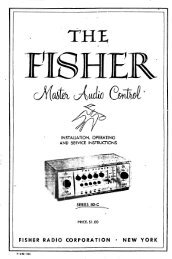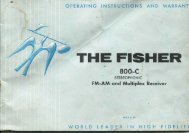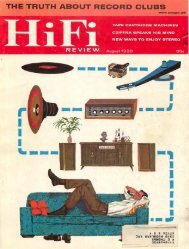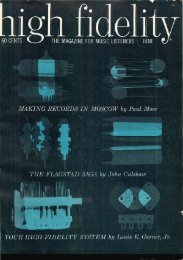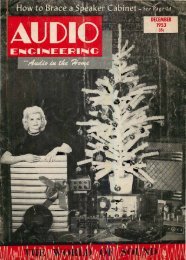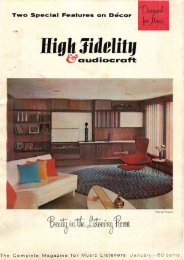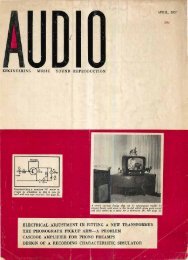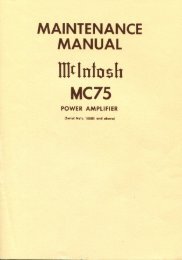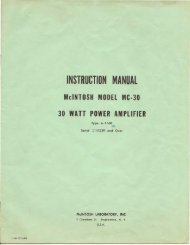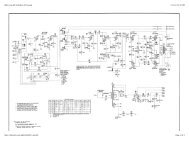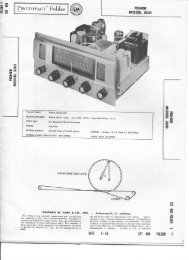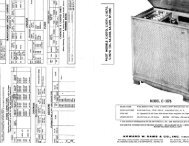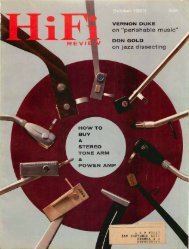~flr'6,r"®
Hifi Stereo Review â July 1958 - Vintage Vacuum Audio
Hifi Stereo Review â July 1958 - Vintage Vacuum Audio
- No tags were found...
You also want an ePaper? Increase the reach of your titles
YUMPU automatically turns print PDFs into web optimized ePapers that Google loves.
1<br />
LANDMARKS OF A GREAT CAREER<br />
Bach-Stokowski: Toccata and Fugue in D<br />
Minor; Debussy-Stokowski: Clair de Lune;<br />
Sibelius: The Swan of Tuonela; Finlandia;<br />
J. Strauss: Blue Danube Waltl.<br />
Leopold Stokowski conducting his Symphony<br />
Orchestra. Capitol ZF 35 $12.95.<br />
This tape consists of orchestral works<br />
especially identified with Stokowski-in<br />
particular his famous transcription of the<br />
Bach D Minor Toccata and Fugue. As<br />
you might expect, all are played to the<br />
hilt with typical Stokowskian flamboyance,<br />
but the real dazzler is the "Toccata."<br />
On the disc version of this program, I was<br />
frankly a bit unllappy about the sound of<br />
the "Toccata." It seemed very thin on<br />
the top end, with the first and second<br />
strings almost 'shrill and with little bass<br />
sonority. On this stereo tape, the situation<br />
is different.<br />
There is much greater perception of<br />
string detail here and the all-important<br />
basses come through with an abundance<br />
of dark, rich power. All other instruments<br />
are cleanly reproduced and there is fine<br />
direction and a good sense of depth. The<br />
violin sound is still a trifle on the strident<br />
side; but all the other amenities of stereo<br />
are hard to overlook. As to-'performance,<br />
little need be said. Here we have, among<br />
other things, a masterful demonstration of<br />
the marvelous string playing he seems to<br />
be able to summon from even a "pickup"<br />
recording orchestra such as is used on<br />
this tape.<br />
RAVEL: Mother Goose-Suite; CHABRIER:<br />
Bourree Fantasque.<br />
Detroit Symphony Orchestra. Paul Paray<br />
condo Mercury MS 5-22 $8.95.<br />
The Ravel suite fares well in stereo<br />
format. This delightful music has had<br />
one previous stereo recording on Concert<br />
Hall, but it cannot compare in either performance<br />
or sound. Paray is in good form<br />
here; his reading is a bit more slowly<br />
paced than most, but has such easy-flowing,<br />
graceful lines that it is head and<br />
shoulders above his competition. The<br />
mike pickup is fairly close-up, and the<br />
"dry" acoustics of the new Ford Civic<br />
Hall in Detroit, allow very little "air"<br />
around the orchestra. Even with stereo<br />
there is just barely enough reverberation<br />
to sustain "liveness."<br />
Paray strikes a lively pace in the spirited<br />
Chabrier "Bouree." This seems to<br />
have a much fuller sound even though<br />
recorded in the same hall. Probably it is<br />
a matter of scoring. In spite of the somewhat<br />
"dry" acoustics, the stereo effects are<br />
easily apparent, with fine separation and<br />
directionality. The middle channel fill in<br />
both works is exceptionally well done.<br />
KHACHATURIAN: Piano Concerto.<br />
Le onard Penna rio with the Concert Arts Orchestra.<br />
Felix Slatki n condo Capitol ZF 52<br />
$12.95.<br />
I was a bit surprised to receive this<br />
tape as the disc version was released almost<br />
three years ago and I had no idea<br />
that Capitol had been recording stereo<br />
that far back. This means, of course, that<br />
there are many other fine performances<br />
that have been recorded in stereo under<br />
the Capitol banner, and it will be a pleasure<br />
to meet some old long play disc<br />
JULY 1958<br />
friends in their bright new stereo trappings.<br />
This is certainly true as applied to<br />
this performance of the colorful Khachaturian<br />
Piano Concerto. I was not too<br />
happy with the sound of the original disc,<br />
but in this stereo version, the sound takes<br />
on new dimension and the results are<br />
spectacular.<br />
Where in the disc the piano seemed<br />
thin and the string body and brass "smallish,"<br />
we now have big, bold piano sound,<br />
nice and clean with little or no transient<br />
distortion; and the string sound has<br />
"opened up" with the full spaciousness<br />
of stereo; the brass too has good bite and<br />
weight. Dynamic range is enhanced with<br />
percussion, especially the tympani having<br />
fine, sharp articulation.<br />
Pennario is a bit hard-toned but this<br />
music can stand it. He has very facile<br />
technique and the fine rhythmic sense all<br />
important to this score. Slatkin affords<br />
perceptive accompaniment and the balance<br />
between piano and orchestra is so<br />
much better than on the disc it is hard<br />
to believe. Some musical sophisticates<br />
consider this trite and blatant music, but<br />
as heard bright and fresh and new on this<br />
stereo tape, it makes for a most stimulating<br />
listening experience.<br />
MARCHING ALONG - Barnum & Bailey's<br />
Favorite; U. S. Field Artillery; The Thunderer;<br />
Washington Post; Stars and Stripes Forever.<br />
Eastman Symphonic Wind En semble. Frederick<br />
Fennell condo Mercury MWS 5-14<br />
$6.95.<br />
It is no exaggeration to state that this<br />
is quite possibly one of the finest band<br />
recordings ever made. It has every element<br />
needed for success. Lives there a<br />
man who hasn't been stirred by the pulsepounding<br />
beat of Sousa's Washington<br />
Post, El Capitan, or The Thunderer, to<br />
say nothing of the great U. S. Field Artillery<br />
March? They are all on this tape<br />
and so is St(l1'S and Stripes Forever! The<br />
tape has the music and it has sound toogreat<br />
masses of it, made-to-order for those<br />
fortunate enough to possess outsize speakers<br />
and 60 watt amplifiers to match.<br />
Brass? It has fire and brilliance and purity<br />
combined with massive sonority. Woodwind?<br />
In rich variety, clean of tone,<br />
lavish witll color. And what percussion!<br />
From the snarly staccato of the snare, the<br />
tweeter-sizzling zing and smash of the<br />
cymbals, and the floor-rattling thud of<br />
bass drum and tympani, it's on this tape<br />
in profusion.<br />
Its effectiveness as a stereo piece is to<br />
be expected, but the most important aspect<br />
here is the sense of balance and<br />
proportion. Needless to say, the dynamic<br />
range is enormous. Free of the restrictions<br />
of stylus swing, the tape can accept<br />
dynamic levels ahnost impossible on a disc<br />
without distortion. Fennell's performances<br />
are models of their kind. His tempi are just<br />
and all moves along at a very brisk pace.<br />
Yet the music's contours are never<br />
blurred, nor is his phrasing in any way<br />
mannered. The playing he elicits from his<br />
band is of truly virtuoso ca\,ibre. Attacks<br />
and releases are clean and precise, and the<br />
homogeneity of the ensemble work sometiling<br />
at which to marvel. In plain English<br />
-this tape is a humdinger. -END<br />
Sound<br />
versus<br />
Noise<br />
People who live next to the railroad<br />
tracks find-after a few sleepless<br />
nights-that human beings have a remarkable<br />
capacity to adjust to irritating<br />
sounds. Psychologists have<br />
learned, however, that while the conscious<br />
mind may shut out bothersome<br />
noise, the "inner man" continues<br />
to be irritated.<br />
Watch a man listening to a phonograph<br />
or a tape recorder with a high<br />
noise level, and you'll see these principles<br />
in operation. Over a period of<br />
time listener fatigue multiplies, until<br />
finally there is an irresistible impulse<br />
to turn the machine off-even though<br />
there has been no specific awareness<br />
of the background noise.<br />
Of course, every machine makes a<br />
little noise, even the finest high fidelity<br />
equipment. In judging quality,<br />
audio engineers use the signal-tonoise<br />
ratio of a machine as a measure.<br />
Reduced to its simplest terms,<br />
the signal-to-noise ratio is the difference<br />
between the loudest electrical<br />
signal the machine can reproduce<br />
satisfactorily and the electrical noise<br />
it produces. It is always stated in<br />
decibels. The greater the signal-tonoise<br />
ratio, the less obtrusive the<br />
noise.<br />
In tape recording and playback,<br />
most noise is caused by the machine.<br />
But some may also be contributed by<br />
the recording tape. This particular<br />
kind of noise, however, is very easily<br />
avoided. Simply use Audiotape. In<br />
Audiotape, you get a better dispersion<br />
of finer magnetic particles. As<br />
a result, you enjoy maximum freedom<br />
from troublesome t:ape noise.<br />
This is just one of the many reasons<br />
why Audiotape is the choice of discriminating<br />
recordists everywhereprofessional<br />
and amateur alike. If<br />
you want more information on tape<br />
recording, you'll be interested in a<br />
book called "How To Make Good<br />
Tape Recordings." Write for free<br />
descriptive folder, Bulletin T, Box<br />
AR, Audio Devices, 444 Madison Avenue,<br />
New York 22, N. Y.<br />
* one 0/ a series<br />
63




